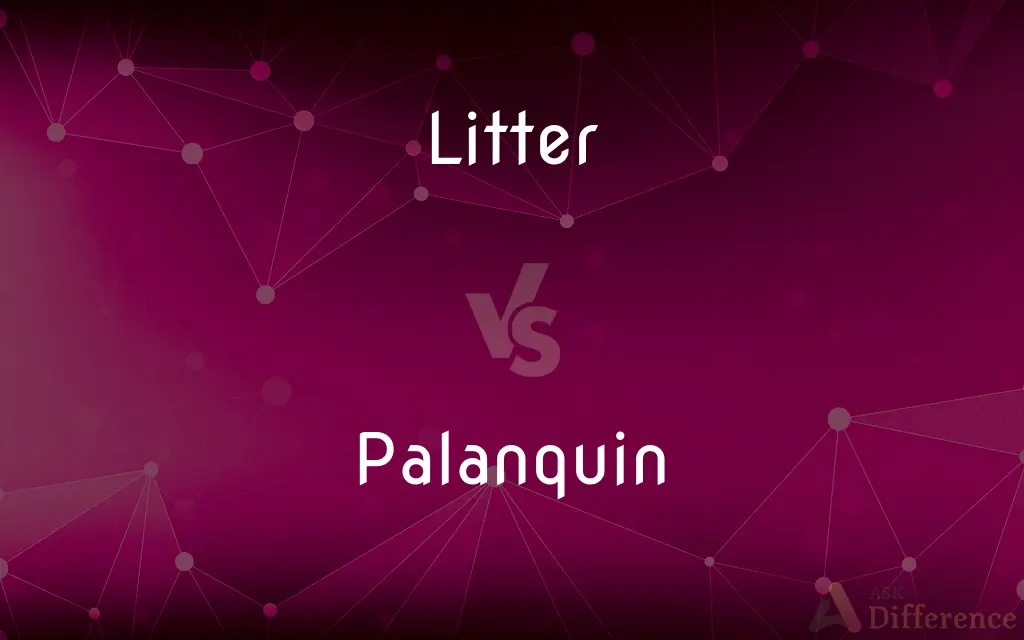Litter vs. Palanquin — What's the Difference?
By Tayyaba Rehman & Fiza Rafique — Updated on March 29, 2024
A litter is a mode of human transport where a passenger compartment is carried by bearers, sticks, or poles. A palanquin, while similar, is a specific type of covered litter, often ornate, used historically in Asia for individual passenger transport.

Difference Between Litter and Palanquin
Table of Contents
ADVERTISEMENT
Key Differences
A litter is a traditional form of transport consisting of a seat or enclosed area that is carried by bearers on poles. It has been used globally in various cultures for transporting individuals, especially those of high social status. On the other hand, a palanquin is a type of litter that is specifically designed to be enclosed and is often associated with luxury and elaborate decoration. It was particularly popular in parts of Asia, such as India and China.
While litters can be simple and utilitarian, designed for function over form, palanquins are known for their aesthetic appeal and craftsmanship. Palanquins typically feature detailed carvings, rich fabrics, and sometimes even gold and silver embellishments, reflecting the wealth and status of the user.
The use of litters dates back to ancient civilizations, including Rome and Egypt, where they served as a means of transport for the nobility and the affluent. Palanquins, meanwhile, became prominent in medieval and early modern Asia, symbolizing not only the social standing but also the cultural sophistication of their occupants.
In terms of operation, both litters and palanquins require human bearers to carry the platform and its passenger. However, the palanquin adds an element of privacy and protection for the rider, thanks to its enclosed structure, which often includes doors or curtains.
Today, both litters and palanquins are mostly found in historical contexts or ceremonial occasions. Their presence echoes a bygone era of human-powered transport, highlighting the social hierarchies and cultural practices of their times.
ADVERTISEMENT
Comparison Chart
Definition
A transport platform carried by poles or bearers
A type of covered and often ornate litter
Origin
Global, ancient civilizations
Asia, particularly India and China
Design
Can be simple or elaborate
Typically enclosed, ornate, and luxurious
Usage
Transporting individuals of high status
Symbolizing wealth and cultural sophistication
Construction
Varies, often less decorative
Highly decorative, with carvings and fabrics
Cultural Significance
Widespread in ancient cultures
Associated with historical Asian nobility
Compare with Definitions
Litter
Global Use.
Litters have been used in various cultures around the world for ceremonial purposes.
Palanquin
Covered Transport.
Palanquins provided a covered and comfortable ride for the royalty in ancient India.
Litter
Design Simplicity.
Military litters were designed for function, facilitating the transport of injured soldiers.
Palanquin
Privacy Feature.
The enclosed structure of palanquins offered privacy to the passengers.
Litter
Transportation Method.
In ancient Rome, litters were used to carry elite citizens across the city.
Palanquin
Artistic Craftsmanship.
Crafting a palanquin was a highly skilled task, reflecting the artisan's expertise in woodwork and decoration.
Litter
Historical Significance.
Litters were a common sight in ancient processions, symbolizing status and power.
Palanquin
Ornate Design.
Royal palanquins were often adorned with intricate carvings and precious metals.
Litter
Construction.
A basic litter might consist of a simple platform with a seat, carried by bearers.
Palanquin
Cultural Icon.
In Chinese history, palanquins were a symbol of the imperial family's prestige.
Litter
Litter consists of waste products that have been discarded incorrectly, without consent, at an unsuitable location. Litter can also be used as a verb; to litter means to drop and leave objects, often man-made, such as aluminum cans, paper cups, food wrappers, cardboard boxes or plastic bottles on the ground, and leave them there indefinitely or for other people to dispose of as opposed to disposing of them correctly.
Palanquin
A covered litter carried on poles on the shoulders of multiple bearers, formerly used in southern and eastern Asia.
Litter
Rubbish such as paper, cans, and bottles left lying in an open or public place
Always clear up after a picnic and never drop litter
A litter bin
Palanquin
A covered type of litter for a stretched-out passenger, carried on four poles on the shoulders of four or more bearers, as formerly used (also by colonials) in eastern Asia.
Litter
A number of young animals born to an animal at one time
A litter of five kittens
Palanquin
An inclosed carriage or litter, commonly about eight feet long, four feet wide, and four feet high, borne on the shoulders of men by means of two projecting poles, - used in India, China, etc., for the conveyance of a single person from place to place.
Litter
Absorbent material, typically in granular form, used to line a shallow receptacle in which a cat can urinate and defecate when indoors
A plastic litter tray
Palanquin
A closed litter carried on the shoulders of four bearers
Litter
Straw or other plant matter used as bedding for animals
The plant burns discarded litter from poultry farms
Litter
A structure used to transport people, containing a bed or seat enclosed by curtains and carried on men's shoulders or by animals.
Litter
Make (a place or area) untidy with rubbish or a large number of objects left lying about
The sitting room was littered with books
Clothes and newspapers littered the floor
Litter
Provide (a horse or other animal) with litter as bedding.
Litter
Carelessly discarded refuse, such as wastepaper
The litter in the streets after a parade.
Litter
A disorderly accumulation of objects; a pile. “An iron washstand [stood] in the corner amidst a litter of soap and soiled towels” (Molly Gloss).
Litter
The group of offspring produced at one birth by a mammal.
Litter
Material, such as straw, used as bedding for animals.
Litter
An absorbent material for covering the floor of an animal's cage or litterbox.
Litter
An enclosed or curtained couch mounted on shafts and used to carry a single passenger.
Litter
Fallen leaves and other decaying organic matter that make up the top layer of a forest floor.
Litter
To give birth to (a litter).
Litter
To make untidy by discarding rubbish carelessly
Someone had littered the beach with food wrappers.
Litter
To scatter about
Littered towels all over the locker room.
Litter
To be scattered about (an area)
“A lot of torn envelopes and open letters littered his bed” (Joseph Conrad).
Litter
To include certain items such as expressions throughout (a speech or piece of writing, for example)
Littered his letters with the names of powerful friends.
Litter
(Archaic) To supply (animals) with litter for bedding or floor covering.
Litter
To give birth to a litter.
Litter
To scatter litter.
Litter
(countable) A platform mounted on two shafts, or a more elaborate construction, designed to be carried by two (or more) people to transport one (in luxury models sometimes more) third person(s) or (occasionally in the elaborate version) a cargo, such as a religious idol.
Litter
The offspring of a mammal born in one birth.
Litter
(uncountable) Material used as bedding for animals.
Sleep in the litter
Litter
(uncountable) Collectively, items discarded on the ground.
Don't drop litter
Put litter in the bin
Litter
(uncountable) Absorbent material used in an animal's litter tray
The cat's litter
Litter
(uncountable) Layer of fallen leaves and similar organic matter in a forest floor.
Litter
A covering of straw for plants.
Litter
(intransitive) To drop or throw trash without properly disposing of it (as discarding in public areas rather than trash receptacles).
By tossing the bottle out the window, he was littering.
Litter
(transitive) To scatter carelessly about.
Litter
(transitive) To strew (a place) with scattered articles.
Litter
(transitive) To give birth to, used of animals.
Litter
(intransitive) To produce a litter of young.
Litter
(transitive) To supply (cattle etc.) with litter; to cover with litter, as the floor of a stall.
Litter
(intransitive) To be supplied with litter as bedding; to sleep or make one's bed in litter.
Litter
A bed or stretcher so arranged that a person, esp. a sick or wounded person, may be easily carried in or upon it.
There is a litter ready; lay him in 't.
Litter
Straw, hay, etc., scattered on a floor, as bedding for animals to rest on; also, a covering of straw for plants.
To crouch in litter of your stable planks.
Take off the litter from your kernel beds.
Litter
Things lying scattered about in a manner indicating slovenliness; scattered rubbish.
Strephon, who found the room was void.Stole in, and took a strict surveyOf all the litter as it lay.
Litter
Disorder or untidiness resulting from scattered rubbish, or from thongs lying about uncared for; as, a room in a state of litter.
Litter
The young brought forth at one time, by a cat, dog, sow or other multiparous animal, taken collectively. Also Fig.
A wolf came to a sow, and very kindly offered to take care of her litter.
Reflect upon that numerous litter of strange, senseless opinions that crawl about the world.
Litter
To supply with litter, as cattle; to cover with litter, as the floor of a stall.
Tell them how they litter their jades.
For his ease, well littered was the floor.
Litter
To put into a confused or disordered condition; to strew with scattered articles; as, to litter a room.
The room with volumes littered round.
Litter
To give birth to; to bear; - said of brutes, esp. those which produce more than one at a birth, and also of human beings, in abhorrence or contempt.
We might conceive that dogs were created blind, because we observe they were littered so with us.
The son that she did litter here,A freckled whelp hagborn.
Litter
To be supplied with litter as bedding; to sleep or make one's bed in litter.
The innWhere he and his horse littered.
Litter
To produce a litter.
A desert . . . where the she-wolf still littered.
Litter
The offspring at one birth of a multiparous mammal
Litter
Rubbish carelessly dropped or left about (especially in public places)
Litter
Conveyance consisting of a chair or bed carried on two poles by bearers
Litter
Material used to provide a bed for animals
Litter
Strew;
Cigar butts littered the ground
Litter
Make a place messy by strewing garbage around
Litter
Give birth to a litter of animals
Common Curiosities
Were litters used only by royalty?
While often associated with royalty and the elite, litters were also used for practical purposes, such as transporting the injured.
How has the use of litters and palanquins evolved over time?
Their use has largely diminished with the advent of modern transportation, surviving today as cultural artifacts or in ceremonial roles.
What is the primary function of a litter?
A litter's primary function is to transport a person, typically of high status, by being carried by bearers.
Can litters and palanquins still be seen today?
Yes, but mostly in historical reenactments, museums, or as part of traditional ceremonies in some cultures.
What materials were used in the construction of palanquins?
Palanquins were made from various materials, including wood for the frame, metal for decorations, and fabrics for covering and interior comfort.
What cultural significance did palanquins have in Asia?
They symbolized wealth, power, and cultural sophistication, being used by nobility and royalty.
How were bearers chosen for carrying litters and palanquins?
Bearers were often specially selected or trained for strength and endurance to carry the weight over distances.
Were there any variations of litters or palanquins used in warfare?
Yes, simpler versions of litters were sometimes used in military contexts for evacuating injured soldiers.
How does a palanquin differ from a standard litter?
A palanquin is a type of litter that is enclosed for privacy and often more elaborately decorated, reflecting higher social status.
Did the design of a palanquin vary by region?
Yes, designs varied significantly, reflecting local cultural, social, and artistic traditions.
How did the construction of litters and palanquins reflect the technological capabilities of a society?
The materials and craftsmanship involved in their construction reflected the technological and artistic achievements of the time.
What role did litters and palanquins play in ceremonies and processions?
They were prominent features in ceremonies, used to display the status of individuals during significant cultural or religious events.
What was the social impact of using litters and palanquins?
They reinforced social hierarchies, visibly distinguishing the social elite from the common populace.
Share Your Discovery

Previous Comparison
Dollar vs. Rupee
Next Comparison
Seizure vs. ConvulsionAuthor Spotlight
Written by
Tayyaba RehmanTayyaba Rehman is a distinguished writer, currently serving as a primary contributor to askdifference.com. As a researcher in semantics and etymology, Tayyaba's passion for the complexity of languages and their distinctions has found a perfect home on the platform. Tayyaba delves into the intricacies of language, distinguishing between commonly confused words and phrases, thereby providing clarity for readers worldwide.
Co-written by
Fiza RafiqueFiza Rafique is a skilled content writer at AskDifference.com, where she meticulously refines and enhances written pieces. Drawing from her vast editorial expertise, Fiza ensures clarity, accuracy, and precision in every article. Passionate about language, she continually seeks to elevate the quality of content for readers worldwide.













































